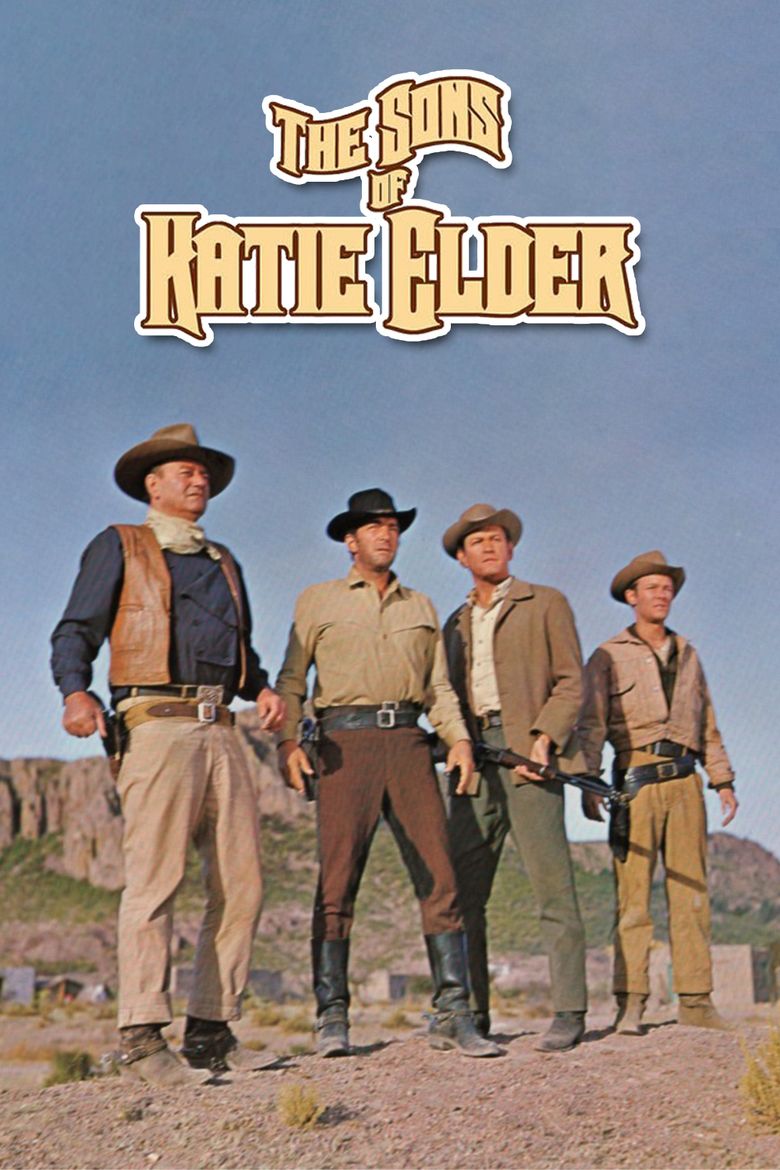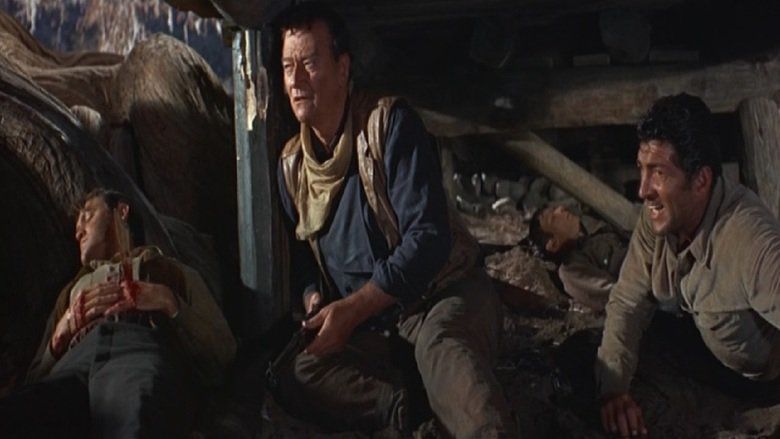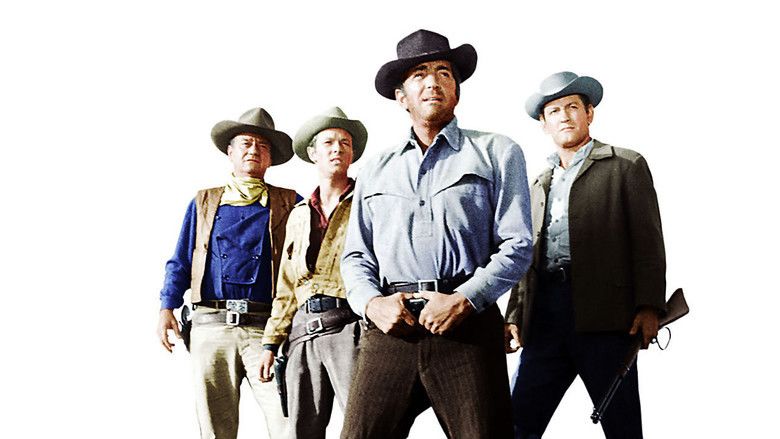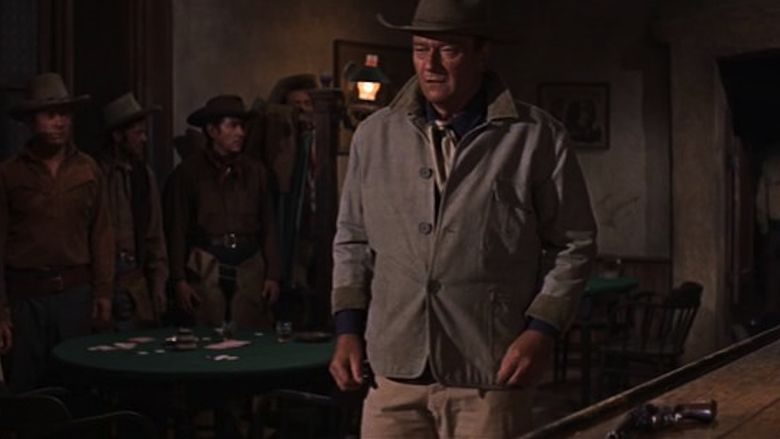The Sons of Katie Elder
7.2 /10 1 Votes
Language English | 7.2/10 IMDb Duration Country United States | |||||||||||||||||||||||||||||||||
 | ||||||||||||||||||||||||||||||||||
Release date July 1, 1965 (1965-07-01) Screenplay Harry Essex, Talbot Jennings, Allan Weiss, William H. Wright Cast (John Elder), (Tom Elder), (Mary Gordon), Michael Anderson Jr. (Bud Elder), (Matt Elder), (Ben Latta)Similar movies Mad Max: Fury Road , The Hunting Party , I Spit on Your Grave III: Vengeance is Mine , Bloody Moon , John Wick , No Good Deed Tagline From the four winds they came, the four brothers, their eyes smoking and their fingers itching... | ||||||||||||||||||||||||||||||||||
The Sons of Katie Elder is a 1965 Technicolor Western Panavision film directed by Henry Hathaway and starring John Wayne and Dean Martin. The movie was filmed principally in Mexico.
Contents

Plot

The four adult sons of Katie Elder – John (John Wayne), who is a famous (or infamous) professional gunman; Tom (Dean Martin), a professional gambler; Bud (Michael Anderson, Jr.), the youngest brother, still in school; and Matt (Earl Holliman), an unsuccessful hardware dealer – reunite in their hometown of Clearwater, Texas (approximately 2 hours east of Dallas, Texas), in 1898 for their mother's funeral, sharing regret that none of them has lived up to her high expectations of them.

The townspeople are unfriendly, to John and Tom in particular. Katie Elder was extremely well liked by everyone in the community, who were all aware of her honesty, her poverty and her undying love for the sons who neglected her. The brothers want to do something for Katie's sake, and their plan is to send youngest son Bud to college, raising money through a sale of another man's herd of horses, even though Bud wants to emulate his eldest brother.

Morgan Hastings (James Gregory), a gunsmith and rising entrepreneur, claims ownership of the Elders' ranch, saying he won it from their father in a game of cards; Bass Elder afterwards was shot in the back, and the killer is still unknown. Hastings hides a hostile attitude towards the brothers and brings in a hired gun, Curley (George Kennedy). Noting Hasting's attitude, the Elders begin to suspect foul play. Hastings claims Bass lost the ranch in a game of Blackjack, so John, in a ruse, states their father wouldn't have been caught dead playing Blackjack.
When Hastings learns about the brothers' investigations, he kills the sheriff (Paul Fix) and frames the Elder brothers for the murder. Then, not content with seeing them go to prison, Hastings arranges an ambush in which Matt is killed and Bud seriously injured. Deputy Ben Latta (Jeremy Slate) is not part of the conspiracy, but is shot and killed by Hastings when he decides to aid the Elders. The surviving Elders escape, and going back to town to get medical help for Bud, John and Tom barricade themselves in the smithy. Tom manages to kidnap Hasting's weak-willed son Dave (Dennis Hopper), although he is seriously injured in the process. Hastings shoots his own boy in an attempt to prevent him from testifying. In the presence of John Elder and the local judge, a wounded Dave manages to relate the tale of his father's crimes before he dies. John takes up arms and kills Hastings by shooting up a cask of gunpowder inside his own gun store.
Cast
Screenplay
William H. Wright picked up a copy of Life of the Marlows in a Los Angeles, California, bookstore in around 1953. Thinking that it would make the basis of a good Western, he paid members of the Marlow family $1,000 (about $8951.49 when adjusted for inflation) each for the rights to make it into a screenplay. But when the movie was made 12 years later, the film's plot had been drastically changed.
Talbot Jennings was credited for the script.
Development
Paramount purchased the story by William Wright and Talbot Jennings in 1955. The story concerned five brothers and centered around a cattle drive from Texas to Colorado. Sam Briskin was assigned as producer. Frank Burt was to write the script, John Sturges was going to direct and Alan Ladd was to star, making a return to Paramount after several years' absence - he still owed Paramount one film left.
Noel Langley signed to write a version of the script, and filming was to start in April 1956. However, in July 1956 it was announced that Ladd had bought himself out of his Paramount commitment by paying $135,000, and he would no longer make the film. (Henry Hathaway put this figure at $250,000.)
Film rights were picked up by Hal Wallis, who had a deal with Paramount. In 1959 it was announced that Dean Martin would star. John Sturges was still attached as director. Eventually in 1964 John Wayne was signed to star, with Henry Hathaway to direct.
Shooting
Filming was due to begin in September 1964, but had to be delayed until January 1965, after Wayne was diagnosed with lung cancer. Following Wayne's surgery to remove a cancerous lung and two ribs, the star insisted on doing his own stunts, and nearly contracted pneumonia after being dragged into a river.
Outdoor locations were filmed in Durango, Mexico, and on the Denver and Rio Grande Western Railroad, Colorado, United States.
Tommy Kirk was signed for the film, presumably in the role of Bud Elder, but his arrest for being at a party where marijuana was used led to his being fired from the production.
The name "Kate Elder" was one of several names used by Mary Katherine Horony Cummings, better known as "Big Nose Kate," a western icon and sometime companion of Doc Holliday.
John Wayne and Dean Martin had also starred in Howard Hawks's Rio Bravo six years earlier, one of Martin's earliest dramatic roles after splitting with his partner Jerry Lewis.
Four years later, Henry Hathaway also directed John Wayne in his Academy Award-winning role of Rooster Cogburn in the original screen version of True Grit. In addition to Wayne, actors Strother Martin, Dennis Hopper, and Jeremy Slate were in that film as well.
This film is famous (or infamous) for one of the most blatantly obvious continuity errors in a western, when John Wayne fires 13 shots from an un-reloaded six-shooter during the final gun battle. Ironically, Wayne, in one of his earliest Hollywood jobs, years before, had been a continuity checker for films.
Song
Johnny Cash sang a song in 1965 also called "The Sons of Katie Elder", written by Elmer Bernstein and Ernie Sheldon. The film's background music was also composed by Elmer Bernstein.
Legacy
The 2005 film Four Brothers was loosely based on The Sons of Katie Elder.
The Malayalam film Big B (2007) is a remake of Four Brothers.
Historical basis
The film was roughly based on the 1888 true story of the five Marlow Brothers (George H., Boone, Alfred, Lewellyn, and Charles) of Graham, Texas, in Young County, and Marlow, Oklahoma.
The city of Marlow, Oklahoma, is named after the Marlow family, including their parents, Dr. Wilburn Williamson Marlow, Sr., and Martha Jane (née Keaton) Marlow. Dr. Marlow was the town's first physician and a prominent citizen. Marlow had previously been a Chisholm Trail rest spot near Wild Horse Creek. There the Marlows built a dugout home called "Marlow Camp" in 1880. Ten years later, the Chicago, Rock Island and Pacific Railroad came through and built a station on the location, naming it Marlow.
Dr. Wilburn and Martha Marlow had four children in addition to the five brothers: Wilburn Williamson "Willie" Marlow, Jr. (died in Leadville, Colorado, in 1879, where he had been taken to convalesce after contracting malaria in Mexico), Charlotte Murphy, Elizabeth "Eliza" Gilmore, and Nancy Jane "Nannie" Murphy. Dr. Marlow died April 12, 1885.
Three of the brothers (Boone, Alfred, and Lewellyn) ended up being killed, although in the film, the brother that had done the real killings (basis for the Dean Martin role) was not with the other four when they were first arrested.
Boone had earlier killed James Holstein (or Holdson or Holston) in 1882, a man allegedly hired to "intimidate settlers," after an inebriated Holdson began shooting at him on the Gilmore farm near Vernon, Texas, just across the Red River from Indian territory (his sister Elizabeth had married into the Gilmore family and the couple had set up a place there). This killing seemed to be justified in self-defense, but would be brought up later by John and William Murphy, deputy marshal Edward W. "Ed" Johnson, and Sam Criswell, who were having a personal feud with Boone, and would be witnesses against the brothers.
Boone, Alfred (aka Alf), Lewellyn (aka Epp, Ep, Ellie), and Charles were arrested near the Anadarko Agency headquarters (what became Anadarko, Oklahoma), for stealing 19 horses in the area around Fort Sill. George went to the homestead in Marlow and took the women by wagon to Graham where he was then also arrested. Martha Jane bailed them out and they went to their place in Young County, a log and clapboard building on the farm of O. G. Denson, fifteen miles southeast of Graham.
Popular sheriff Marion DeKalb Wallace and his deputy Thomas B. "Tom" Collier went out to the Denson farm, December 17, 1888. Before they left Graham they had been drinking and were intoxicated. The Marlows (Charles and his wife, Alfred's wife, Martha, Lewellyn, and Boone Marlow) were sitting down to noon dinner. Boone saw Collier through the window and invited him in for dinner, to which Collier replied, "I'm not hungry." An altercation broke out between Collier and Boone, and without showing their warrant, Collier fired at Boone. As Wallace heard the commotion he came around from the other side of the house and came up behind Collier. Boone, aiming at Collier, shot sheriff Wallace by mistake. As Collier and Charles attended to Wallace, Boone left the area. The other four brothers went into town and turned themselves in.
A mob then tried to avenge the sheriff and attacked the jail, January 17, 1889, but the brothers were able to fight off the mob.
On January 19, 1889 (after dark), the deputy then decided to move the four brothers to Weatherford, Texas, chained together along with two other prisoners (William D. Burkhart and Louis Clift). But the two wagons and one buggy were ambushed along the way at Dry Creek (about two miles from Graham). The deputies guarding the brothers ran away, in league with the ambush party.
The brothers managed to get some weapons, get to cover, and hold off the attack, but Alfred and Lewellyn were killed. Also killed were three of the mob that attacked the Marlows: Frank Harmison, Sam Criswell, and Bruce Wheeler. George and Charles were both wounded (Charles severely so) but escaped, using Burkhart as a hostage and being aided by Clift, and went to their mother's house on the Denson farm. (About halfway there, they stopped in Finis at a farm house and asked to stay the night, but were refused. George spotted an ax and borrowed it to separate the men from their shackles. As soon Burkhart was free, he ran off). Also wounded were Johnson, Logan, and Clinton "Clint" Rutherford. The Marlows stayed at their mother's home until lawmen came from outside Young County, and then gave themselves up. Deputy U.S. Marshal W. F. Morton of Dallas finally arrived, took them into custody, and transported them, first toward Weatherford and then, fearing another ambush, to Dallas.
"This is the first time in the annals of history where unarmed prisoners, shackled together, ever repelled a mob. Such cool courage that preferred to fight against such great odds and die in glorious battle." Judge Andrew Phelps McCormick, 1891.Boone had gone to stay with his girlfriend and her family, the Harbolts, in the vicinity of Marlow, but the girlfriend's brother, William "G.E." Harbolt, put some poison in the food that his sister took to Boone. William Harbolt had obtained the poison from a Dr. Carter. Harbolt, along with bounty hunters Jim "Martin" Beavers and John E. Derrickson (aka Direkson), shot his dead body for the $1,700 reward offered for his capture ($200 by the State of Texas and $1,500 by Young County), dead or alive. An autopsy by Doctor R. N. Price determined that he was already dead when he had been shot, and that he had died of arsenic poisoning. The three men were arrested but released on bail. Harbolt was later shot in the Chickasaw Nation and Beavers and Derrickson each received 15-year sentences.
The five Marlow brothers had been falsely accused of stealing horses, and after the shootout that left three dead, George and Charles were finally acquitted in a Dallas trial. The two brothers then moved to Colorado and became deputies.
As deputy marshal Ed Johnson was lying wounded at his home, he gave a newspaper interview to the Graham Leader. In the interview, he said that deputy sheriff Eugene Logan had been one of the guards taking the prisoners to Weatherford, and had been wounded in doing so. In fact, Logan had not been one of the guards but one of the men in the ambush party. The insistence that something be done in the edition of January 24 of the Graham Leader, and this slip up by Johnson, started an investigation into the affair by the U.S. marshal for the Northern District of Texas in Dallas, William Lewis Cabell. In addition, the U.S. attorney sent an investigator to Young County.
Collier, deputy Johnson, David "Dink" Allen, attorney Robert "Bob" Holman, Jack Wilkins, W. R. Benedict, county attorney Phlete A. Martin, deputy tax collector John Levell, constable Marion A. Wallace (the dead sheriff's nephew), Wil Hollis, William Bee Williams, Richard "Dick" Cook, deputy sheriff Eugene Logan, constable Sam Waggoner, Clint Rutherford, and Verna Wilkerson were all charged with conspiring to falsify a case against the Marlow brothers, conspiring to kill the Marlow brothers in an ambush, and murdering Alfred and Lewellyn Marlow while they were in the protective custody of a United States Marshal. However, only Cook, Hollis, Levell, Logan, Rutherford, Waggoner, Wallace, Wilkerson, and Williams, went to trial.
John William "Bee" Williams and Thomas B. Collier (typhoid fever) died while in jail in mid-January 1891.
George and Charles were summoned to testify and asked for and received protective custody from U.S. Marshal George A. Knight of Dallas. Additionally, Knight made George a "Special Deputy", while Charles was made an "attached witness". Phlete A. Martin and John Frank Spears (Spears was in jail with the Marlows at the time of the mob attack) both turned state's evidence and testified against the conspirators.
Clinton Rutherford was found not guilty on November 22, 1890, and the court removed Rutherford from the indictment, but bound over Eugene Logan and Verna Wilkerson. Logan, Waggoner, and Wallace were found guilty of conspiracy and not guilty of murder on April 17, 1891, and each sentenced to a $5,000 fine and ten years imprisonment. The other defendants (Cook, Levell, Hollis, and Wilkerson) were found not guilty.
The case involving Eugene Logan, William Williams, Verna Wilkerson, and Clinton Rutherford (United States v. Eugene Logan et al.) was separated from the other defendants, and went all the way to the United States Supreme Court. (See Logan v. United States, 144 U.S. 263 (1892), filed March 16, 1891.)
"A citizen of the United States, in the custody of a United States Marshall under a lawful commitment to answer for an offense against the United States, has the right to be protected by the United States against lawless violence; this right is a right secured to him by the Constitution and laws of the United States, and a conspiracy to injure or oppress him in its free exercise or enjoyment is punishable under section 5508 of the Revised Statutes."The city of Graham had wanted to keep a federal court in their town, but after this incident the federal government denied that request.
References
The Sons of Katie Elder WikipediaThe Sons of Katie Elder IMDb The Sons of Katie Elder themoviedb.org
